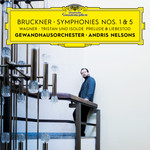|
Back
02/12/2022
Anton Bruckner: Symphony No. 1 in C minor, WAB 101 (Vienna version 1890/91; edition Günter Brosche) – Symphony No. 5 in B-Flat major, WAB 105 (Original version 1878; edition Leopold Nowak)
Richard Wagner: Tristan und Isolde, WWV 90: Prelude to Act I and Isoldes Liebestod
Gewandhausorchester Leipzig, Andris Nelsons (conductor)
Recording: Gewandhaus, Leipzig, Germany (May 2019, November 2020, May 2021) – 120’27
Deutsche Grammophon 4862083

   
The centerpiece of this collection, Andris Nelsons’ Leipzig reading of Bruckner’s Fifth Symphony, defies easy qualitative assessment. For beauty of sound, especially in the sheer weight of the Leipzig orchestra, it is hard to fault, and in particular I commend Nelsons’ choice not to rein the orchestra in at climaxes, which are extremely powerful but not aggressive—something like an ideal in Bruckner. There, for instance, a magical lightness about the finale’s magnificent coda, a real sense of joyous release. The slow movement—to my mind, Bruckner’s greatest but for its counterpart in the Eighth—also is strikingly rich and warm; to me, it’s the most effective single movement in the performance.
Where Nelsons can be bothersomely self-conscious is in his phrasing of melodic lines, whose wings he tends to clip. Listen, for instance, to the initial statements of any of the fugal themes in the finale, which are tapered after the manner common to purportedly historically informed performances of early music, and compare them to the work of a conductor like Karajan or Schuricht, where beautiful playing (in, admittedly, less pristine sound, although in some ways I prefer good analogue to digital for its better simulation of ambience) is joined to a greater intensity of expression. Granted, the first of these themes is somewhat jagged—but such clipped articulation denies the music its full measure of urgency and lyricism. I don’t demand all legato, all the time, but sometimes under Nelsons the music fails to really sing, and to no impressive dramatic effect. The best thing I can say for it here is that it makes for a light touch in what is perhaps Bruckner’s most austere, and to some listeners most unduly portentous, symphony. That weight and warmth of sound keep the sometimes underwhelming shaping of lines from trivializing the work—I can imagine several American orchestras turning this interpretive approach charmless and crude—and the overall effect certainly works, if not as consistently as it might have. And that resplendent final coda is a big asset in a work whose main climax only comes at the very end. The best things, in short, largely compensate for the weak spots.
The First Symphony brings the same wonderful playing, and is by no means phoned in. The main question is whether general liveliness, warmth and virtuosity are enough in a work where Bruckner’s melodic inspiration is more fitful than it would become. There is a lot to enjoy here, but an old-timer like Volkmar Andreae shaped every phrase of the First with enough imagination, tenderness and propulsion to bring it alive and make its skittering quirkiness—this is Bruckner at his least solemn, quite a contrast to the Fifth—playful rather than chaotic. (I think string historian Tully Potter is right to praise older generations of players for carefully modeling their playing off singers, a practice less common today.) Nelsons gives a fine rendition, but I am not sure it alone would sell anyone on this elusive work.
Working in reverse order through the program, I conclude by noting that the bleeding chunks from Tristan are in keeping with the rest: beautifully played, if not the last word in passion and drama. Like their Brucknerian discmates, they would be more memorable in a less crowded discographic field.
Samuel Wigutow
|